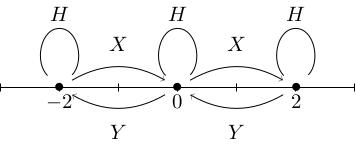Take the subspace spanned by . I claim that is a subrepresentation.
Classifying SU(2) representations
Review
We have seen that for every complex representation we get a Lie algebra representation (by complexifying ; we'll usually omit the superscript and sometimes even the ). We have a basis of which satisfy the commutator relations
We've seen that where , and that and . The spaces are called weight spaces and the s are called weights.
We depict this by drawing a weight diagram with a blob at each integer point for which (and somehow indicating the dimension of ).

Highest weight vectors
Pick a vector where is the weight that is furthest to the right in the diagram. Such a weight exists because is finite-dimensional. Act on using the matrices , , and (which we're now calling , and for brevity). Because is a representation, all vectors we obtain in this way are again in .
because , so we may as well start by applying a bunch of times to obtain the following elements: Here, I've ordered these elements by increasing weight: each time we apply we decrease weight by , so . Also, let's define to be the biggest power of we can apply before we get zero, that is: (Again this is guaranteed to exist because is finite-dimensional).

If is irreducible then this implies . In other words, any irreducible representation of has a weight diagram that looks like a string of dots spaced out in twos ( with each weight space 1-dimensional (spanned by for some ).
To check that is a subrepresentation, we need to check that if and we apply , or to then the result is still in . We will check this for running over the basis .
If we apply to then we get , and all these vectors are still in .
If we apply to we get because . Again, this stays in the subrepresentation .
If we apply , there is a formula which we will prove separately: This implies the lemma because it shows .
The formula
Consequences of the formula
We'll prove the formula in a moment, but first here are some remarks.
The formula makes sense because increases weight by and while .
The formula tells us that the irreducible representation with highest weight is completely determined up to isomorphism by (i.e. there's a unique irrep with highest weight up to isomorphism). This is because we know how all the matrices , , act on the basis :
-
-
-
.
The only choice we have is picking the vector , but different s differ only by a scale factor as is 1-dimensional, and this just amounts to changing our whole basis by a scale factor.
We can now deduce that is isomorphic to the representation : we've seen both of these have the same weight diagram.
The formula also tells us that (the biggest power of for which but ) is equal to . Therefore the weights in our representations go from down to .
To see why , note that but and , so and hence .
Proof of formula
We now prove the formula We prove it by induction on .
For , and , so both sides agree.
Suppose it's true for all numbers strictly less than . We know that . Since is a representation of Lie algebras this formula is still true if we stick in front of everything (which is good, since we're omitting mention of from the formulae). Let's apply to :
Therefore . Using our formula to evaluate and the fact that , we get which simplifies to give our formula (exercise!).
Once again, the bracket relations in have played a crucial role in the proof.
Summary
With this formula in hand, we have now established these nice facts:
-
the weight diagrams of representations are symmetric about the origin
-
there's a unique irrep with highest weight , whose weight diagram has 1-dimensional weight spaces with weights (spaced out by 2, starting at and ending at ).
Pre-class exercise
Check that simplifies to give